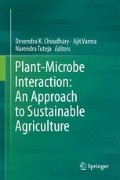Abstract
Phyllosphere is the most abundant environment that supports microbial life. This ecosystem is a stress environment characterized by fluctuation in moisture, nutrients, radiation and plant’s own immune system. However, plants support microbial community on the phyllosphere as a strategy for its survival and growth. This chapter addresses general characterization of phyllospheric environment, microbial association process, microbial population structure, quorum sensing and cross talk between plant and microbes. This chapter provides information on the microbial diversity of the phyllosphere of bioenergy crop Jatropha curcas. Major bacterial groups prevalent on the J. curcas phyllosphere and plant growth-promoting activities are addressed.
Access this chapter
Tax calculation will be finalised at checkout
Purchases are for personal use only
References
Agarwal P, Singh S, Mastan SG et al (2015) Soil microbial diversity shift as affected by conversion of shallow and rocky wastelands to Jatropha curcas L. plantation. Int J Environ Stud 72:1–19
Belkin S, Qvit-Raz N (2010) Life on a leaf: bacterial epiphytes of a salt-excreting desert tree. In: Symbioses and stress. Springer, Dordrecht, pp 393–406
Bulgarelli D, Schlaeppi K, Spaepen S et al (2013) Structure and functions of the bacterial microbiota of plants. Annu Rev Plant Biol 64:807–838
del Rocío Mora-Ruiz M, Font-Verdera F, Díaz-Gil C et al (2015) Moderate halophilic bacteria colonizing the phylloplane of halophytes of the subfamily Salicornioideae (Amaranthaceae). Syst Appl Microbiol 38:406–416
Dourado MN, Aparecida Camargo Neves A, Santos DS, Araújo WL (2015) Biotechnological and agronomic potential of endophytic pink-pigmented Methylotrophic Methylobacterium spp. Biomed Res Int 2015:909016
Esser DS, Leveau JH, Meyer KM, Wiegand K (2015) Spatial scales of interactions among bacteria and between bacteria and the leaf surface. FEMS Microbiol Ecol 91:fiu034
Finkel OM, Burch AY, Elad T et al (2012) Distance-decay relationships partially determine diversity patterns of phyllosphere bacteria on Tamrix trees across the Sonoran Desert. Appl Environ Microbiol 78:6187–6193
Gal M, Preston GM, Massey RC et al (2003) Genes encoding a cellulosic polymer contribute toward the ecological success of Pseudomonas fluorescens SBW25 on plant surfaces. Mol Ecol 12:3109–3121
Galbally IE, Kirstine W (2002) The production of methanol by flowering plants and the global cycle of methanol. J Atmos Chem 43:195–229
George TS, Gregory PJ, Wood M et al (2002) Phosphatase activity and organic acids in the rhizosphere of potential agroforestry species and maize. Soil Biol Biochem 34:1487–1494
Hardoim PR, van Overbeek LS, van Elsas JD (2008) Properties of bacterial endophytes and their proposed role in plant growth. Trends Microbiol 16:463–471
Hartmann A, Rothballer M, Hense BA, Schröder P (2015) Bacterial quorum sensing compounds are important modulators of microbe-plant interactions. Plant Microb Import Plant Hum Health 41:131
Hutchison ML, Tester MA, Gross DC (1995) Role of biosurfactant and ion channel-forming activities of syringomycin in transmembrane ion flux: a model for the mechanism of action in the plant-pathogen interaction. Mol Plant-Microbe Interact 8:610–620
Iguchi H, Yurimoto H, Sakai Y (2015) Interactions of methylotrophs with plants and other heterotrophic bacteria. Microorganisms 3:137–151
Jager ES, Wehner FC, Korsten L (2001) Microbial ecology of the mango phylloplane. Microb Ecol 42:201–207
Jha CK, Saraf M (2012) Evaluation of multispecies plant-growth-promoting Consortia for the growth promotion of Jatropha curcas L. J Plant Growth Regul 31:588–598
Jo Y, Cho JK, Choi H et al (2015) Bacterial communities in the phylloplane of Prunus species. J Basic Microbiol 55:504–508
Kishore GK, Pande S, Podile AR (2005) Phylloplane bacteria increase seedling emergence, growth and yield of field grown groundnut (Arachis hypogaea L.). Lett Appl Microbiol 40:260–268
Kwak M-J, Jeong H, Madhaiyan M et al (2014) Genome information of Methylobacterium oryzae, a plant-probiotic methylotroph in the phyllosphere. PLoS One 9:e106704
Liu Y, Wang H, Sun X et al (2011) Study on mechanisms of colonization of nitrogen-fixing PGPB, Klebsiella pneumoniae NG14 on the root surface of rice and the formation of biofilm. Curr Microbiol 62:1113–1122
Madhaiyan M, Poonguzhali S (2014) Methylobacterium pseudosasicola sp. nov. and Methylobacterium phyllostachyos sp. nov., isolated from bamboo leaf surfaces. Int J Syst Evol Microbiol 64:2376–2384
Morris CE, Monier J, Jacques M (1997) Methods for observing microbial biofilms directly on leaf surfaces and recovering them for isolation of culturable microorganisms. Appl Environ Microbiol 63:1570–1576
Morris CE, Barnes MB, McLean RJC et al (2002) Biofilms on leaf surfaces: implications for the biology, ecology and management of populations of epiphytic bacteria. Phyllosphere microbiology. American Phytopathological Society, St. Paul, pp 139–155
Quigley NB, Gross DC (1994) Syringomycin production among strains of Pseudomonas syringae pv. syringae: conservation of the syrB and syrD genes and activation of phytotoxin production by plant signal molecules. Mol Plant Microb Interact 7:78
Schreiber L, Krimm U, Knoll D et al (2005) Plant–microbe interactions: identification of epiphytic bacteria and their ability to alter leaf surface permeability. New Phytol 166:589–594
Seo S, Matthews KR (2014) Exposure of Escherichia coli O157: H7 to soil, manure, or water influences its survival on plants and initiation of plant defense response. Food Microbiol 38:87–92
van der Wal A, Tecon R, Kreft J-U et al (2013) Explaining bacterial dispersion on leaf surfaces with an individual-based model (PHYLLOSIM). PLoS One 8:e75633
Zehr JP (2011) Nitrogen fixation by marine cyanobacteria. Trends Microbiol 19:162–173
Acknowledgment
This work is part of the project entitled “Metagenomic characterization and spatiotemporal changes in the prevalence of microbes involved in nutrient cycling in the rhizoplane of bioenergy crop Jatropha curcas.” The authors acknowledge the Department of Biotechnology, Government of India, for financial support to SRM. The authors declare no conflict of interest of any type.
Author information
Authors and Affiliations
Corresponding author
Editor information
Editors and Affiliations
Rights and permissions
Copyright information
© 2016 Springer Nature Singapore Pte Ltd.
About this chapter
Cite this chapter
Mohanty, S.R., Dubey, G., Ahirwar, U., Patra, A.K., Kollah, B. (2016). Prospect of Phyllosphere Microbiota: A Case Study on Bioenergy Crop Jatropha curcas . In: Choudhary, D., Varma, A., Tuteja, N. (eds) Plant-Microbe Interaction: An Approach to Sustainable Agriculture. Springer, Singapore. https://doi.org/10.1007/978-981-10-2854-0_20
Download citation
DOI: https://doi.org/10.1007/978-981-10-2854-0_20
Published:
Publisher Name: Springer, Singapore
Print ISBN: 978-981-10-2853-3
Online ISBN: 978-981-10-2854-0
eBook Packages: Biomedical and Life SciencesBiomedical and Life Sciences (R0)

